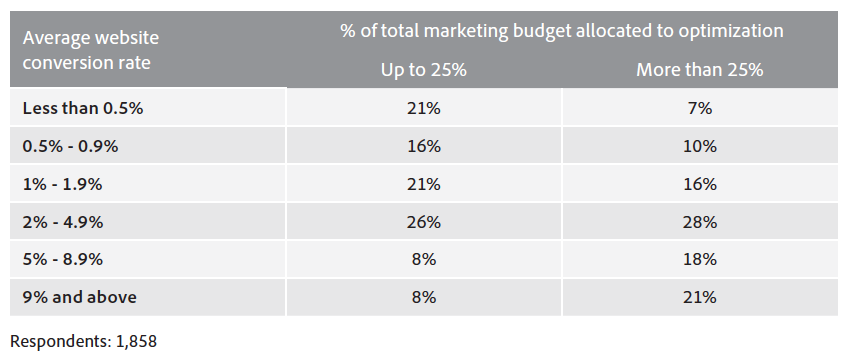Customer engagement and conversion – the two words every digital marketer likes to hear. (Ok, technically that is three words but who’s counting?)
Engaging customers online and optimizing their digital experience across channels can mean millions in revenue for companies. However, while digital marketers are talking about optimization, are they implementing it successfully to maximize the investment?
This is what Adobe aimed to find out in its 2013 Digital Marketing Optimization Survey and the results are in. Over 1,800 responses from around the world– including North America, Europe, and Asia – proved that comprehensive optimization and targeting programs directly drive increased conversion. Here’s what we learned:
Optimization still isn’t considered a marketing priority
- ****A majority of companies surveyed spend 5% or less of their marketing budget on optimization activities
However, the companies that do invest more, reap the benefits
- Companies spending more than 25% of their marketing budgets towards optimization are twice as likely to enjoy high conversion rates.
What is holding companies back?
- For almost half the survey respondents, testing isnot a priority at their company (yet)
- Budget and resources remain the two biggest challenges to testing
A cross-departmental approach can improve chances of higher conversion rates
- A third of companies in which multiple departments have input testing processes say conversion rates are 5% or higher
- Our analysis shows companies whose customers react “very positively” to targeting efforts have higher conversation rates and invest more of their marketing budget than others.
- 55% of digital marketers surveyed said personalization is “very” or “somewhat” important to the long-term goals of their organization.
Site search is still an untapped opportunity
- Site search is a fundamental aspect of findability that includes tactics such as keyword matching; displaying products/content based on ratings, highest conversions, or promotions; and targeting results based on visitor profile.
- Yet, more than half of the respondents are unaware of the impact of site search techniques beyond the baseline functionality of keyword matching. The majority of those who use site search optimization tactics find them to be effective.
Automated recommendations are a hidden gem
- A product/content recommendation is a natural personalization tactic that dramatically improves engagement and conversion goals.
- Media and Financial Services companies finally recognize these benefits and plan to deploy recommendations this year.
- Meanwhile, 38% of digital marketers still aren’t taking advantage of this yet.
- Nearly half do not optimize their recommendation strategies and rely heavily on manual updates. Only 18% are using an automated approach.
Don’t forget their mobile devices!
- Last year, Adobe Analytics saw a doubling of traffic from mobile devices but less than half of the survey respondents said they have a mobile-optimized site or mobile app.
- Companies with mobile-optimized sites triple their chances of increasing mobile conversion rate to 5% or above.
Social plays an important role but needs measurement
- Social sharing increases conversion rates; with 2 in 5 companies responding that it is “very effective”.
- However, most companies still fly blind when it comes to measuring success – only 47% use social media analytics today.
- Only 6% use attribution modeling, which can assist in understanding the interactions between social and other channels in their mix.
This year’s responses indicate that while companies are starting to invest and advance in digital marketing optimization, there is still plenty of work to do. It’s never been easier for businesses to adopt optimization technology for testing, tailoring, and delivering a meaningful digital experience to their customers. Whether you are just getting started, or planning your next steps in your digital marketing efforts, keep these insights in mind:
- Testing is the core of any personalization and optimization program. Start with small wins, and expand efforts from there; failed tests are just as impactful in lessons learned.
- Optimized targeting breeds customer satisfaction and conversion. Leveraging consumer data such as stated preferences, past and current onsite behavior, social graphs, and location can assist in tailoring content that resonates with visitors and pulls them to interact.
- Site search is an untapped opportunity for optimization; navigation works best when it offers specific routes to content. By testing and tailoring site search tactics including keyword matching, promotion of high converting items, and user profile targeted results, you can unveil the optimal experience to deliver a visitor to maximize conversion and revenue.
- Automated recommendations are not just for digital commerce; all industries can realize the benefits of this natural personalization strategy. Powering relevant suggestions across all digital channels is a proven way to increase consumer engagement, confidence, and loyalty with a brand.
- Nearly every consumer is a mobile consumer—is your mobile presence optimized? Determine the goal of your mobile initiatives; look at your analytics, then decide which mobile tactics best address your businesses needs now and in the future.
- Don’t fly blind when it comes to social. Use moderation and measurement tools to guide conversations toward a positive impact for your business.
So how do you stack up against your digital marketing peers? See what they are doing to get ahead—from basic optimization practices to robust strategies designed to maximize conversion. Visit Adobe.com and download the complete Adobe 2013 Digital Marketing Optimization Survey: http://adobe.ly/14NYkio

